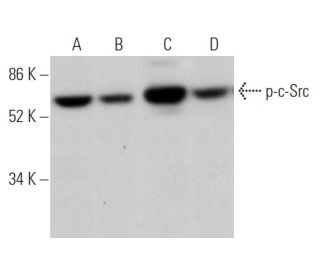
p-Src Antikörper (H-3): sc-166860
- p-Src Antikörper (H-3) ist ein Maus monoklonales IgG2b κ, verwendet in 26 wissenschaftlichen Veröffentlichungen, in einer Menge von 200 µg/ml
- p-Src Antikörper (H-3) ist empfohlen für die Detektion von Tyr 530 phosphorylated c-Src of human and rat origin, and Tyr 535 phosphorylated c-Src of mouse origin per WB, IP, IF, IHC(P) und ELISA
- Anti-p-Src Antikörper (H-3) ist erhältlich als Konjugat mit Agarose für IP; HRP für WB, IHC(P) und ELISA; und entweder mit Phycoerythrin oder FITC für IF, IHC(P) und FCM
- auch erhältlich als Konjugat mit Alexa Fluor® 488, Alexa Fluor® 546, Alexa Fluor® 594 oder Alexa Fluor® 647 für IF, IHC(P) und FCM
- auch erhältlich als Konjugat mit Alexa Fluor® 680 oder Alexa Fluor® 790 für WB (NIR), IF und FCM
- 2b BP-HRP">m-IgG2b BP-HRP und m-IgGκ BP-HRP sind die bevorzugten sekundären Nachweisreagenzien für p-Src Antikörper (H-3) für WB- und IHC(P)-Anwendungen. Diese Reagenzien werden jetzt in Bündeln mit p-Src Antikörper (H-3) angeboten(siehe Bestellinformationen unten).
Direktverknüpfungen
Siehe auch...
p-c-Src/Src-Antikörper (H-3) ist ein monoklonaler Maus IgG2b κ p-c-Src-Antikörper, der Tyr 530 phosphorylierte c-Src von humaner und Rattenherkunft sowie Tyr 535 phosphorylierte c-Src von muriner Herkunft von Maus, Ratte und Mensch durch WB, IP, IF, IHC(P) und ELISA detektiert. p-c-Src/Src-Antikörper (H-3) ist als nicht-konjugierte Form des Anti-p-c-Src-Antikörpers sowie als mehrere konjugierte Formen des Anti-p-c-Src-Antikörpers, einschließlich Agarose, HRP, PE, FITC und mehreren Alexa Fluor®-Konjugaten, erhältlich. Die Hauptübersetzungsprodukte des Src-Genfamilien sind membranassoziierte Tyrosin-Protein-Kinasen, die keine transmembranen und externen Aminosäuresequenzen aufweisen. Aufgrund ihrer gemeinsamen Strukturmotive besteht die Src-Familie aus neun Mitgliedern in Wirbeltieren, einschließlich c-Src, c-Yes, Fgr, Yrk, Fyn, Lyn, Hck, Lck und Blk. Src-Familienkinasen, die einen aminoterminalen Zellmembrananker gefolgt von SH3- und SH2-Domänen enthalten, transduzieren Signale, die an der Kontrolle einer Vielzahl von Zellprozessen beteiligt sind, einschließlich Proliferation, Differenzierung, Motilität und Adhäsion. Src-Familienmitglieder werden normalerweise in einem inaktiven Zustand gehalten und können während Zellvorgängen wie der Mitose vorübergehend aktiviert werden. Verschiedene subzelluläre Lokalisationen von Src-Familienkinasen können für die Regulation bestimmter zellulärer Prozesse wie der Mitogenese, der zytoskelettalen Organisation und des Membrantransports wichtig sein. c-Src (auch als pp60Src, Src p60 und proto-onkogener Tyrosin-Protein-Kinase Src bezeichnet) wird in einer breiten Palette von Geweben und Zelltypen exprimiert, obwohl die höchsten c-Src-Spiegel in neuronalen Geweben und Thrombozyten nachgewiesen werden. c-Src kann eine Rolle bei Ereignissen spielen, die sowohl mit der neuronalen Differenzierung als auch mit der Aufrechterhaltung reifer neuronaler Zellfunktionen verbunden sind.
Alexa Fluor® ist ein Markenzeichen von Molecular Probes Inc., OR., USA
LI-COR® und Odyssey® sind Markenzeichen von LI-COR Biosciences
p-Src Antikörper (H-3) Literaturhinweise:
- Das Herpesvirus-Saimiri-Protein StpB assoziiert mit zellulärem Src. | Hör, S., et al. 2001. J Gen Virol. 82: 339-344. PMID: 11161272
- Die Regulierung der onkogenen Aktivität des zellulären src-Proteins erfordert den korrekten Abstand zwischen der Kinasedomäne und dem C-terminalen phosphorylierten Tyrosin (Tyr-527). | Cobb, BS., et al. 1991. Mol Cell Biol. 11: 5832-8. PMID: 1719372
- Phosphoryliertes c-Src im Zellkern ist mit einem verbesserten Behandlungsergebnis bei ER-positivem Brustkrebs verbunden. | Campbell, EJ., et al. 2008. Br J Cancer. 99: 1769-74. PMID: 19018258
- Phosphoryliertes c-Src ist ein neuartiger Prädiktor für Rezidive bei Patienten mit zervikalem Plattenepithelkarzinom. | Hou, T., et al. 2013. Int J Clin Exp Pathol. 6: 1121-7. PMID: 23696930
- Das zelluläre src-Genprodukt reguliert die Zell-Zell-Kommunikation an den Verbindungsstellen. | Azarnia, R., et al. 1988. Science. 239: 398-401. PMID: 2447651
- Sphingosin-Kinase 2 verhindert die nukleare Translokation von Sphingosin-1-Phosphat-Rezeptor-2 und Tyrosin-416-phosphoryliertem c-Src und erhöht das Wachstum von Östrogenrezeptor-negativen MDA-MB-231-Brustkrebszellen: Die Rolle von Sphingosin-1-Phosphat-Rezeptor-4. | Ohotski, J., et al. 2014. Cell Signal. 26: 1040-7. PMID: 24486401
- Extrazelluläre Vesikelaktivierung von latentem HIV-1 wird durch EV-assoziierten c-Src und zellulären SRC-1 über den PI3K/AKT/mTOR-Weg angetrieben. | Barclay, RA., et al. 2020. Viruses. 12: PMID: 32575590
- Phospholipase C-gamma 1 assoziiert mit viralen und zellulären src-Kinasen. | Nakanishi, O., et al. 1993. J Biol Chem. 268: 10754-9. PMID: 8388373
- Assoziation von Tyrosin-phosphoryliertem c-Src mit dem Zytoskelett des hypertrophierenden Myokards. | Kuppuswamy, D., et al. 1997. J Biol Chem. 272: 4500-8. PMID: 9020175
- Genetische Variation des transformierenden Proteins der Herpesvirus-Saimiri-Untergruppe A und seine Assoziation mit zellulärem src. | Lee, H., et al. 1997. J Virol. 71: 3817-25. PMID: 9094657
Bestellinformation
| Produkt | Katalog # | EINHEIT | Preis | ANZAHL | Favoriten | |
p-Src Antikörper (H-3) | sc-166860 | 200 µg/ml | RMB2377.00 | |||
p-Src (H-3): m-IgGκ BP-HRP Bundle | sc-521777 | 200 µg Ab, 40 µg BP | RMB2662.00 | |||
p-Src (H-3): m-IgG2b BP-HRP Bundle | sc-548965 | 200 µg Ab; 10 µg BP | RMB2662.00 | |||
p-Src Antikörper (H-3) AC | sc-166860 AC | 500 µg/ml, 25% agarose | RMB3129.00 | |||
p-Src Antikörper (H-3) HRP | sc-166860 HRP | 200 µg/ml | RMB2377.00 | |||
p-Src Antikörper (H-3) FITC | sc-166860 FITC | 200 µg/ml | RMB2482.00 | |||
p-Src Antikörper (H-3) PE | sc-166860 PE | 200 µg/ml | RMB2580.00 | |||
p-Src Antikörper (H-3) Alexa Fluor® 488 | sc-166860 AF488 | 200 µg/ml | RMB2685.00 | |||
p-Src Antikörper (H-3) Alexa Fluor® 546 | sc-166860 AF546 | 200 µg/ml | RMB2685.00 | |||
p-Src Antikörper (H-3) Alexa Fluor® 594 | sc-166860 AF594 | 200 µg/ml | RMB2685.00 | |||
p-Src Antikörper (H-3) Alexa Fluor® 647 | sc-166860 AF647 | 200 µg/ml | RMB2685.00 | |||
p-Src Antikörper (H-3) Alexa Fluor® 680 | sc-166860 AF680 | 200 µg/ml | RMB2685.00 | |||
p-Src Antikörper (H-3) Alexa Fluor® 790 | sc-166860 AF790 | 200 µg/ml | RMB2685.00 | |||
p-Src (H-3) Neutralizing Peptid | sc-166860 P | 100 µg/0.5 ml | RMB511.00 |
